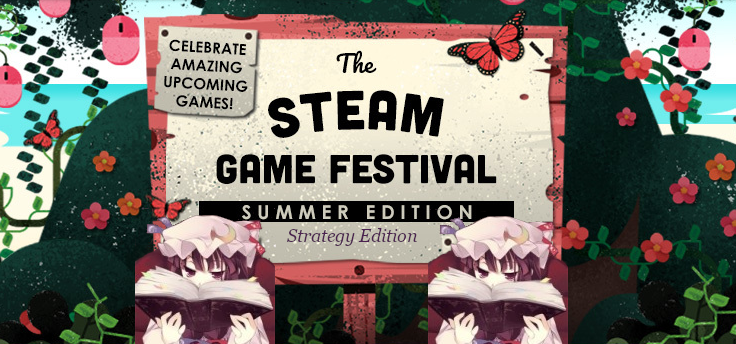The ones to watch and the ones to pass by.
The Steam Summer Game Festival 2020, a spotlight that shines upon upcoming games that have demos available has now concluded, but having played ten games as in-depth as a demo would let me, this article is here to try to bring your attention to something you might have otherwise missed. (Note that while the festival is over, most of these games still have their demos available for download and play at any time, although that number has been going down as I type this.) Rgk also did a rundown of games, and so I decided to try to make a list “focused” on strategy games. By which I mean I hit the “strategy” tab and picked ten games from the top of the recommendations I had not heard of before this and ran through them blind. (Note: Not all of these are really strategy games, but, well, that’s Steam’s categorization system for you.)
Counting down in alphabetical order, we have:
Creeper World 4
Obviously, the latest in an indie franchise, Creeper World 4 is apparently a step into full 3d from what was a 3d world that was displayed in 2d in previous games. Creeper World lies somewhere between a tower defense game and a real-time strategy game with the twist being that your enemy is an implacable fountain of purple slime that can only be held by with extreme quantities of high explosive. The slime advances constantly, flowing into low-lying areas first, and destroying anything it touches, while you as a player need to rapidly gobble up land of your own for the resource income you need to fight the slime. There is a single constantly-generated main resource of energy (gained by putting “soylant” collectors over mostly-flat land, and yes they cover it with green) which is used both for constructing new building and weapons as well as feeding them ammo (except for some special weapons that take alternate resources). Not only does ammo cost energy, but weapons need to be on the power grid to receive that ammo, so expanding your power grid as you push your front forwards is the basics of the game. An additional aid to your fight is that you can tell your turrets to move, and they just fly up on rocket boosters and gradually drift to new positions. (But watch out, as they stop firing and stop being reloaded when they do this.) Hence, you need to leapfrog your way to victory, gradually forcing the slime back and advancing your power grid until you can corner the slime to its emitters. Each map is “scored” (with global leaderboards) in terms of speed and how few units you needed to build, giving you an incentive to not build as recklessly and be as efficient as possible.
An interesting way that the 3d works in this game is that your basic cannon can only fire on its own elevation or slightly downwards (and even then, you need to bring it right up to the edge), but it is cheap and very rapid-firing. Other weapons like the mortars have the ability to ignore elevation when attacking within its range, and wipe out more slime per attack, but are much more expensive and slower-firing. Sometimes, the best method of assault is to just toss a cannon right into the breech as soon as you get a toehold on a chunk of land and hope it holds out long enough to reinforce.
The creeper isn’t going to just take being shot lying down (it’s more of a viscous flow than any kind of posture, really), however, and every few levels, there’s a new trick up what really should be some mindless slime’s sleeve, including spore launchers that can fling slime into the back of the map where you’ve moved your guns away. Because you need to maintain a power grid, having slime flung when I wasn’t looking to a place I lacked coverage twice cut off a critical link in my chain of power relays over rough terrain that actually cut power to one of my nullifiers, making me have to refight a front I’d thought already won. Shooting these spore bombs down requires AA missile turrets that require a special ore to produce.
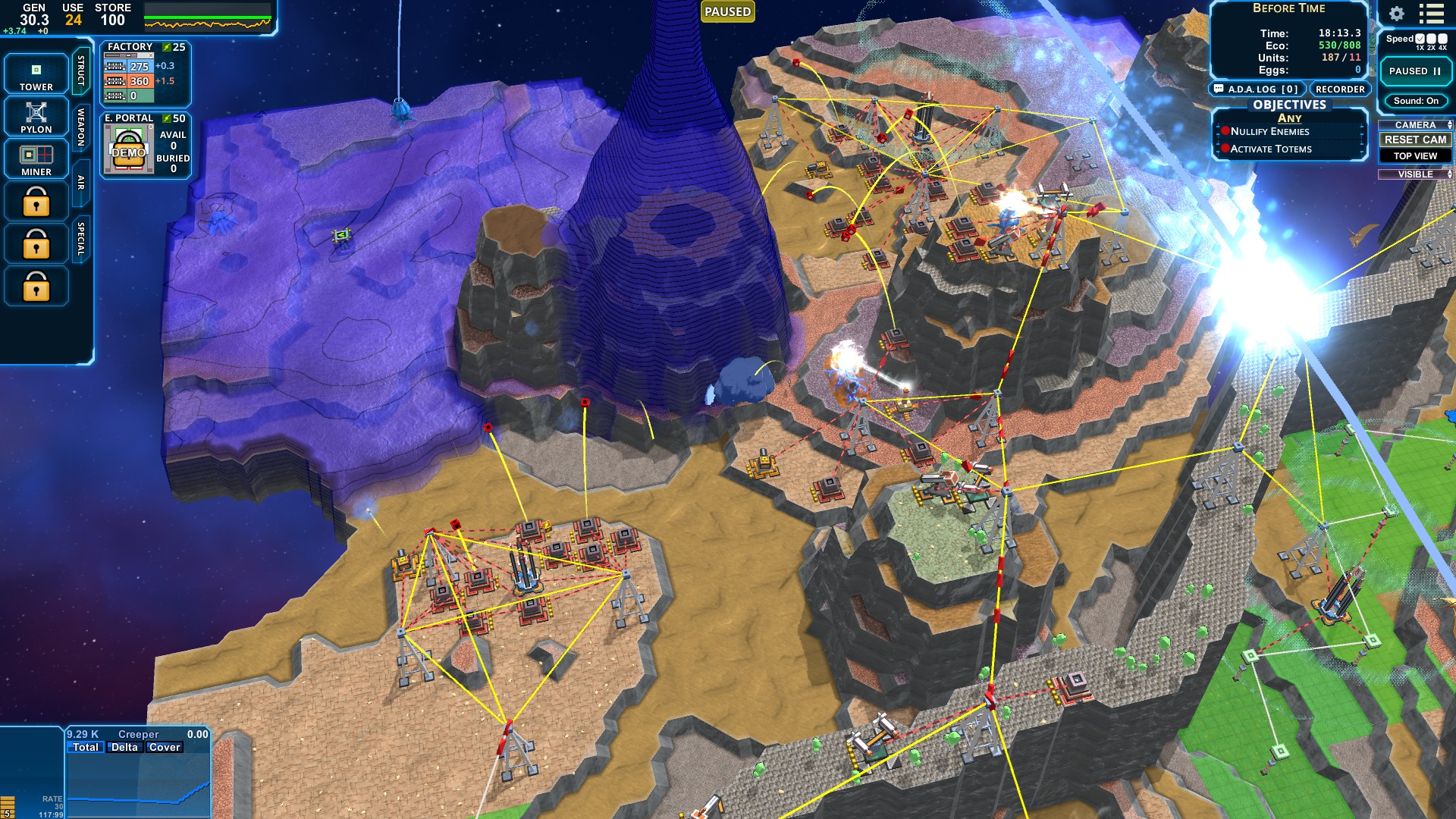
Another surprise are the creepers, which are leech-like things that pop out of large scab-like structures, can hover through space where there is no land, and kamikaze your structures, and are only vulnerable to “Sniper” turrets. Together with the spores, while they can be shut down with properly-placed specialty turrets, the main function is to posssibly open up new fronts in a fight that otherwise becomes very locked in place as you focus upon leapfrogging your way to victory.
The only problem I have is that the story seems to presume you know what happened with the main character’s grandpa or something that seems to have happened in a previous game. Hopefully by the time it’s a full game there will be more “tutorial” that will explain the plot a little better.
The Dungeon Of Naheulbeuk: The Amulet Of Chaos
Naheulbeuk (I will never feel like I’m spelling that correctly without checking twice) tries to be a satire of classic Dungeons and Dragons tropes. The problem is, it’s the bad kind of satire that thinks telling the same jokes that were tired and overdone 40 years ago but rolling their eyes and doing it “ironically” will somehow make it funny again. The characters are such caricatures that they don’t even have names, they’re just “The Barbarian”, “The Wizardess” (no, “Wizard” is a unisex title, I don’t care what J.K. Rowling thinks), or “The Elf”. Incidentally, The Elf is pure dumb blonde stereotype who reveals maximum cleavage and jiggles her butt at the camera every chance she gets. They can’t even properly pull off the “The Barbarian is dumb as bricks” joke because The Dwarf is such a suicidally stupid chump who deliberately trips every trap on the party that the Barbarian comes across more as the silent, worthless one who went down first in every battle where anyone went down. (The Barbarian missed every single attack past the first round of combat where it was a tutorial and I think it was rigged to work. This is one of those games that tells you you have a “90% chance to hit” and then secretly has several separate chances to miss after that so you can easily miss “90% chances to hit” 75% of the time, and The Barbarian has one of the lower chances to hit to start with…)
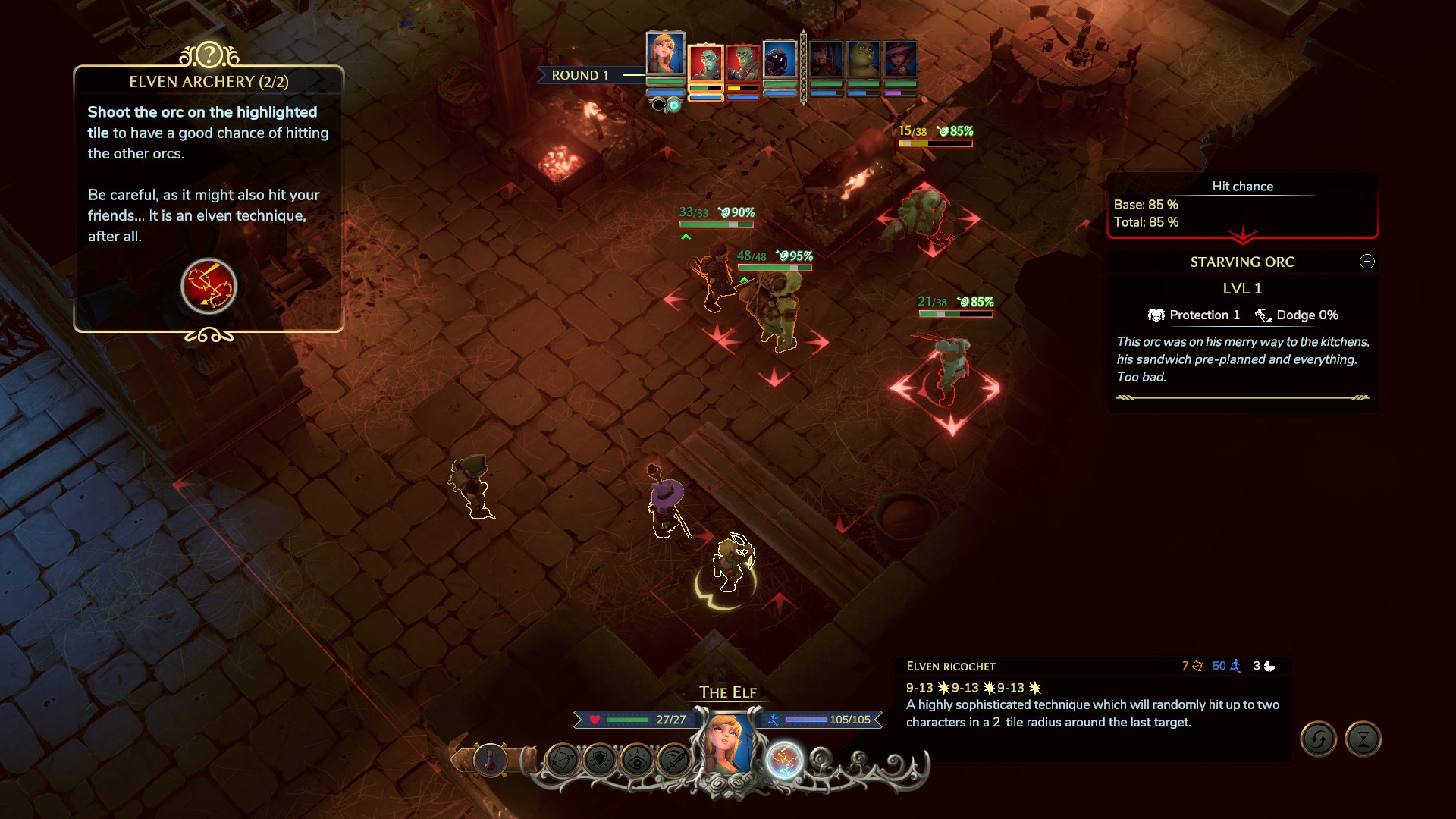
You have no choice over party composition because the point is that they want to whine to you about how bad players of RPGs like you are, so you have to have a dwarf, and The Dwarf has to be described as “just a dwarf” because all dwarves are the same. (The perpetual cry of people with no imagination of their own who ignore the RP other players are trying to involve the other players in…) Likewise, the two characters who have no armor or hit points and have to be kept in the back row behind the meat shields are of course the sole female characters. No imagination was used in the creation of this “satire”. (Also, “The Ranger” has no wilderness skills, has no favored foes, is not specialized in ranged or dual-wielding combat, and instead has a sword and board and teamwork bonuses for leading troops to give them a bonus to evasion. In short, he’s the fighter, but apparently they wanted to make the “main character” look like Viggo Mortensen even though there’s nothing related to Lord of the Rings other than through D&D in this game. Not the most important thing, but if you’re going to be doing a knowing wink and nod joke to the D&D players, at least learn the damn game, first…)
Actual tactical combat is very like one of those post-Blizzardification “streamlined” (read: further dumbed-down) versions of Fourth Edition D&D. You get all of two skills with multi-round cooldowns per character at the start with a grand total of four (and you don’t get to pick four out of a list, just four per character), and “The Wizardess” has to also be the cleric and heal people because these kinds of games can’t be bothered to make a dedicated healer even in a party with 7 characters. Since most of your skills are on cooldown at any given time, the game seems to be played more by the RNG determining whether anything you throw out hits than the player’s own choices deciding things.
Maybe, once you get more levels and can actually unlock a few other perks there may actually be some tactics to this tactical RPG, but for the love of god, the “jokes” in this game are far too insufferable to see if the gameplay can claw its way up to mediocre to in any way redeem itself.
Skip this one. NEXT!
Fae Tactics
Next we have another tactical RPG game that wears its inspiration on its sleeve: This is a game that very much wants to be Final Fantasy Tactics Advance, and good on it for trying, because there’s so much from the golden era of the DS that Nintendo has let die that indie developers need to step in and breathe life back into.
The plot follows Peony, a pink-haired girl who wears earmuffs with goggles on them while also wearing a sleeveless shirt who looks like she’s constantly high and attacks with a magic gun, and her two best pals, a dog that acts as the front-line fighter and a water bird that acts as artillery. The plot at first is just about her trying to fix her bike, having to fight gremlin bandits for the parts, but since the opening talks about how the world was nearly destroyed when the human and fae worlds collided, and how Peony is a magic-using human that is an “ill omen that brings disaster” and the game is freakin’ subtitled “The girl who destroyed the world”, that’s probably where this is going to go. All told, it’s plot didn’t feel particularly gripping for what little I saw, and the game was mostly focused upon the combat.
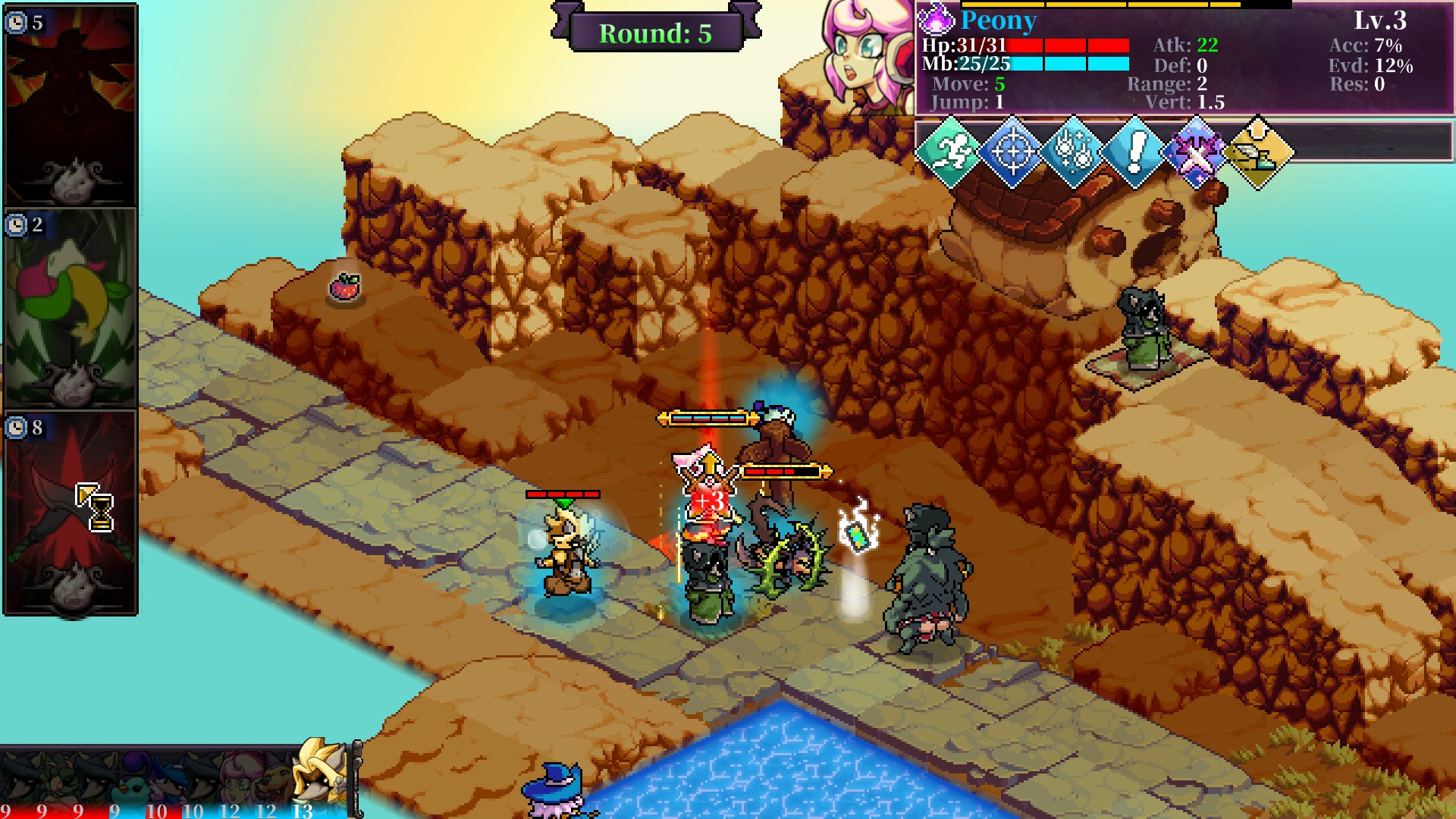
So far as tactical depth goes, it’s a little difficult to judge when you can capture enemy characters and send them out as “summoned” units, yourself, as I need to see the full range of enemy abilities to really get the full sense. Characters have a single direct attack, a support skill based upon their element in the game’s elemental rock-paper-scissors, a wait/idle skill, and then passive skills that are specific to that creature type. It’s hard to say if it’s more tactically deep than something like Naheulbeuk, but it’s a far sight less skeevy or insipid in its storytelling, so I have far more interest in actually playing this game to find out.
The Final Earth 2
(There’s no official trailer for this one on YouTube, so have more screenshots of my games…)
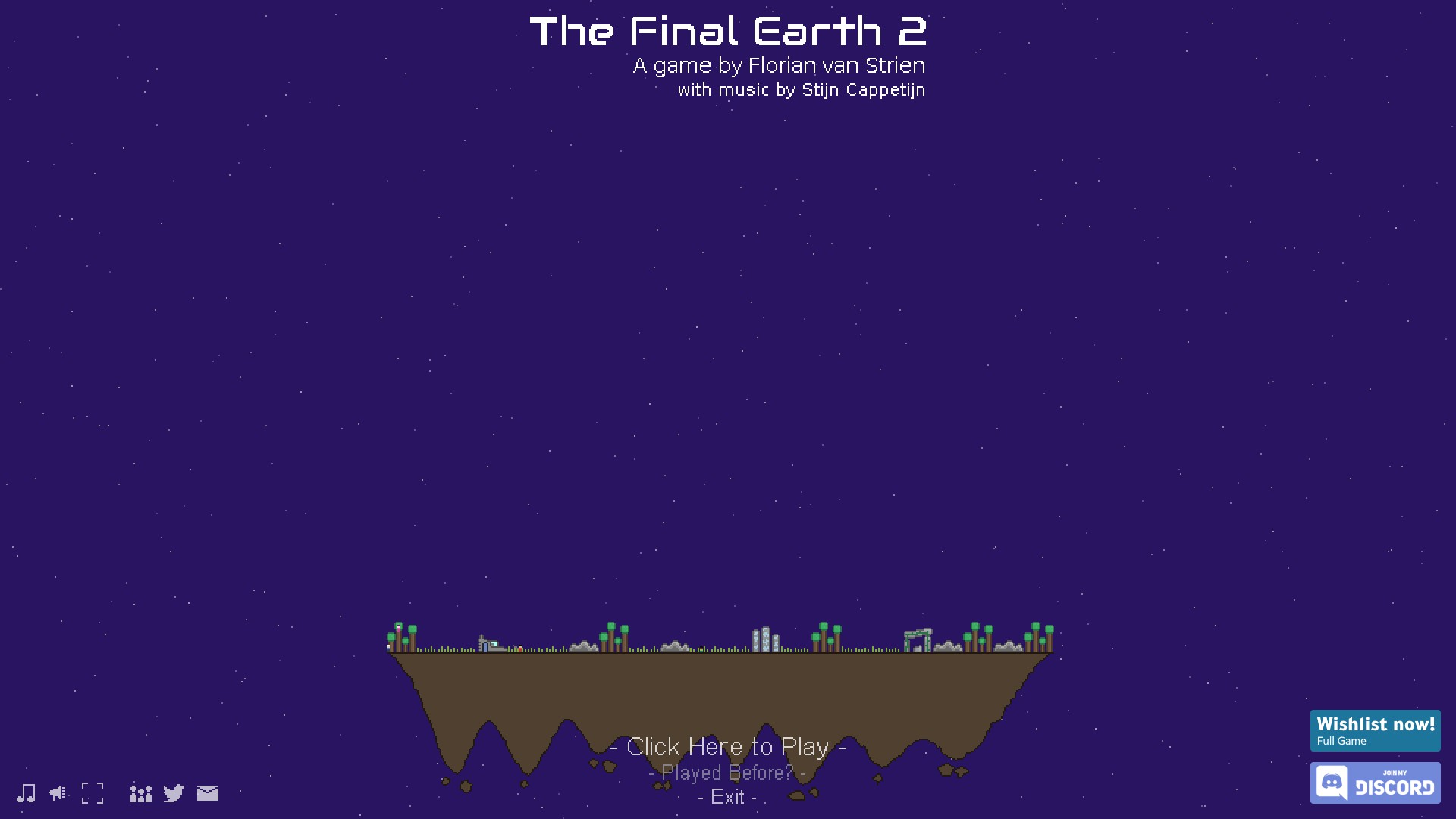
The Final Earth 2 claims to be about rebuilding humanity’s home among… the stars?… Maybe? Space ships land settlers on floating earthbergs where you can start mining for resources and trying to build your way up to a gleaming metropolis from humble beginnings chopping down trees for resources. The game reminds me most of two things: The first is Kimi no Shima with its aggressively indie pixelated art style and its focus upon resource gathering and production chains. Unlike Kimi no Shima, however, this game at least has a limited number of resources that you can monitor via a counter at the bottom right of the screen at all times. The second is SimTower (and all its attempted successors), thanks in no small part to the physics-defying way you can just stack floor after floor on top of existing buildings without needing to strengthen the foundation even if the bottom floors were made of plywood.
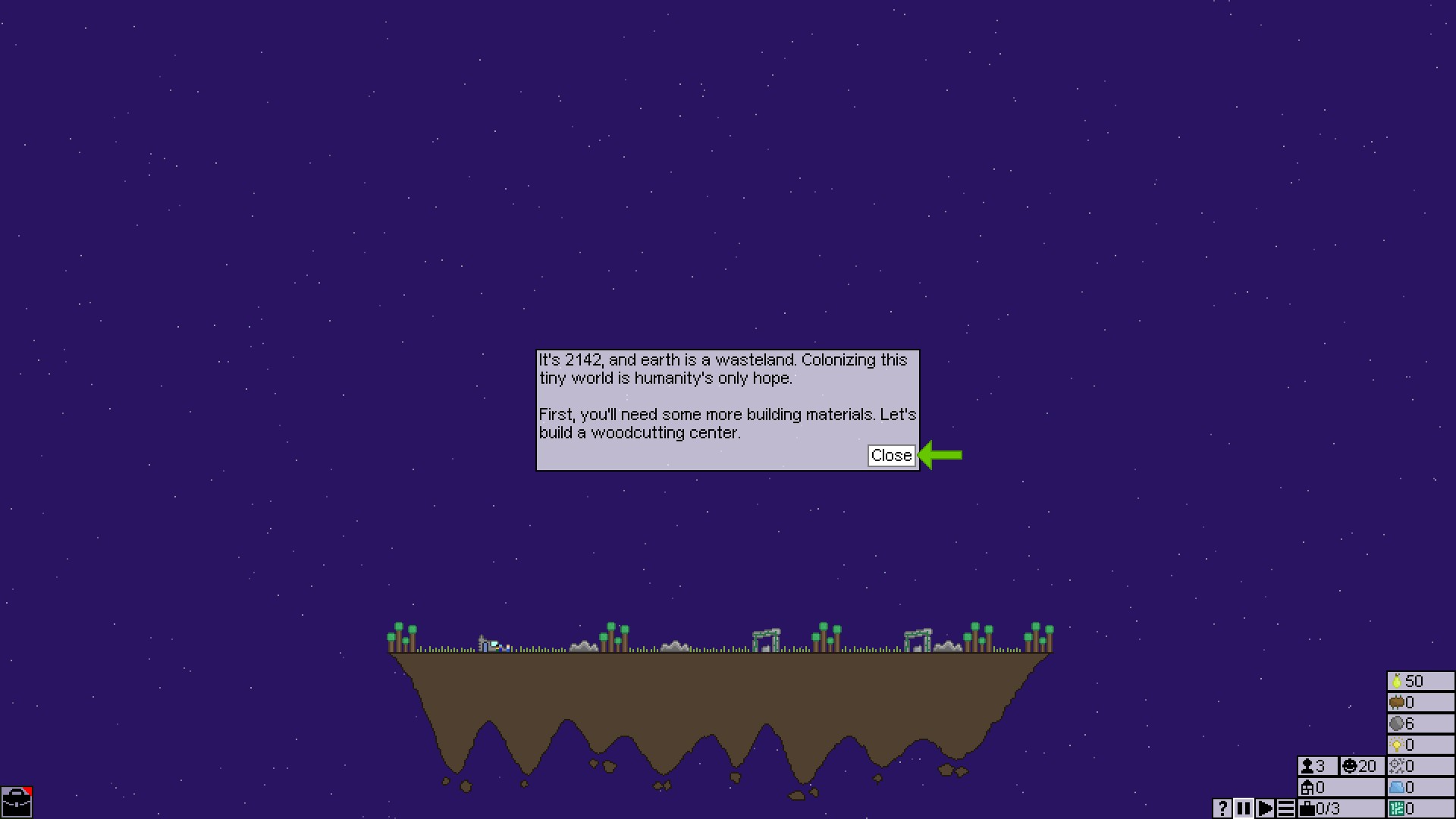
Speaking of building out of plywood and reminding me of Kimi no Shima, The Final Earth 2 exists in some weird nebulous technology era somewhere between the Stone Age and Jetpack Future. You start out like Minecraft building pickaxes out of wood and then “upgrading them” by building better pickaxes out of stone. You can then create glass terrarium hydroponics buildings with nothing but a few rocks. You then chisel stone into “machine parts” like gears, and use some stone and gears to create UFOs that can fly around between floating earthbergs. When you unlock metallurgy, you get “hyper elevators” that are basically Star Trek’s turbolifts, and getting up to microchips from there gives you teleporters for instantaneous commutes. You build teleporters that suck down asteroids so your miners – who are still using stone pickaxes can mine infinite stone. Meanwhile, some buildings in your 50-floor-tall super skyscraper are literally made of nothing but wood.
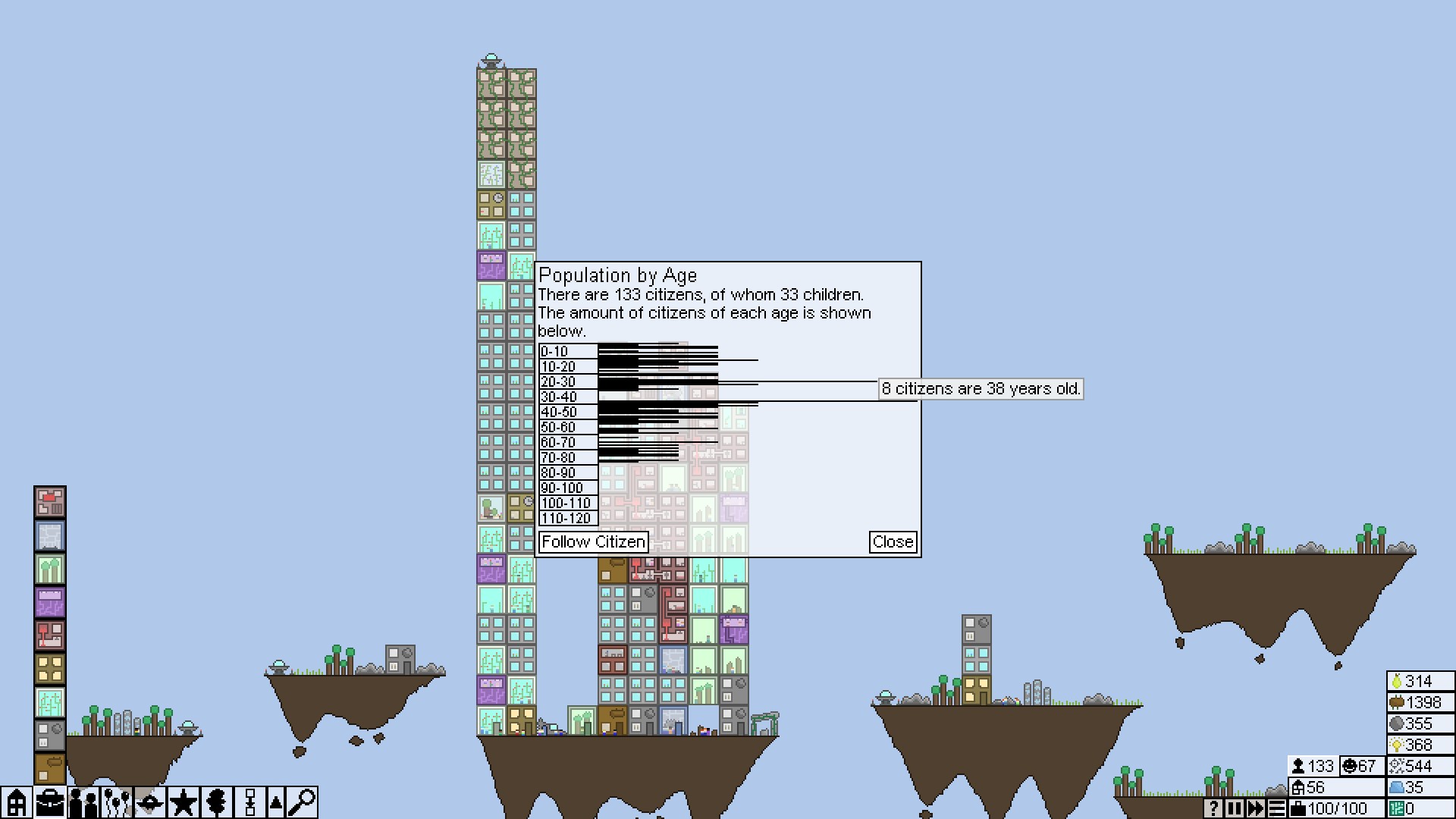
The game plays very casually, and outright suggests you just make towers that are pretty rather than efficient, but that runs against my optimizer blood, and many buildings are designed with adjacency bonuses to other types of buildings. For example, labs can give orthogonally-adjacent farms (either food or tree) growth bonuses, encouraging building in interlocking “+” shapes. I also focused upon efficiency and set up hyper elevators and teleporters for extremely short commutes.
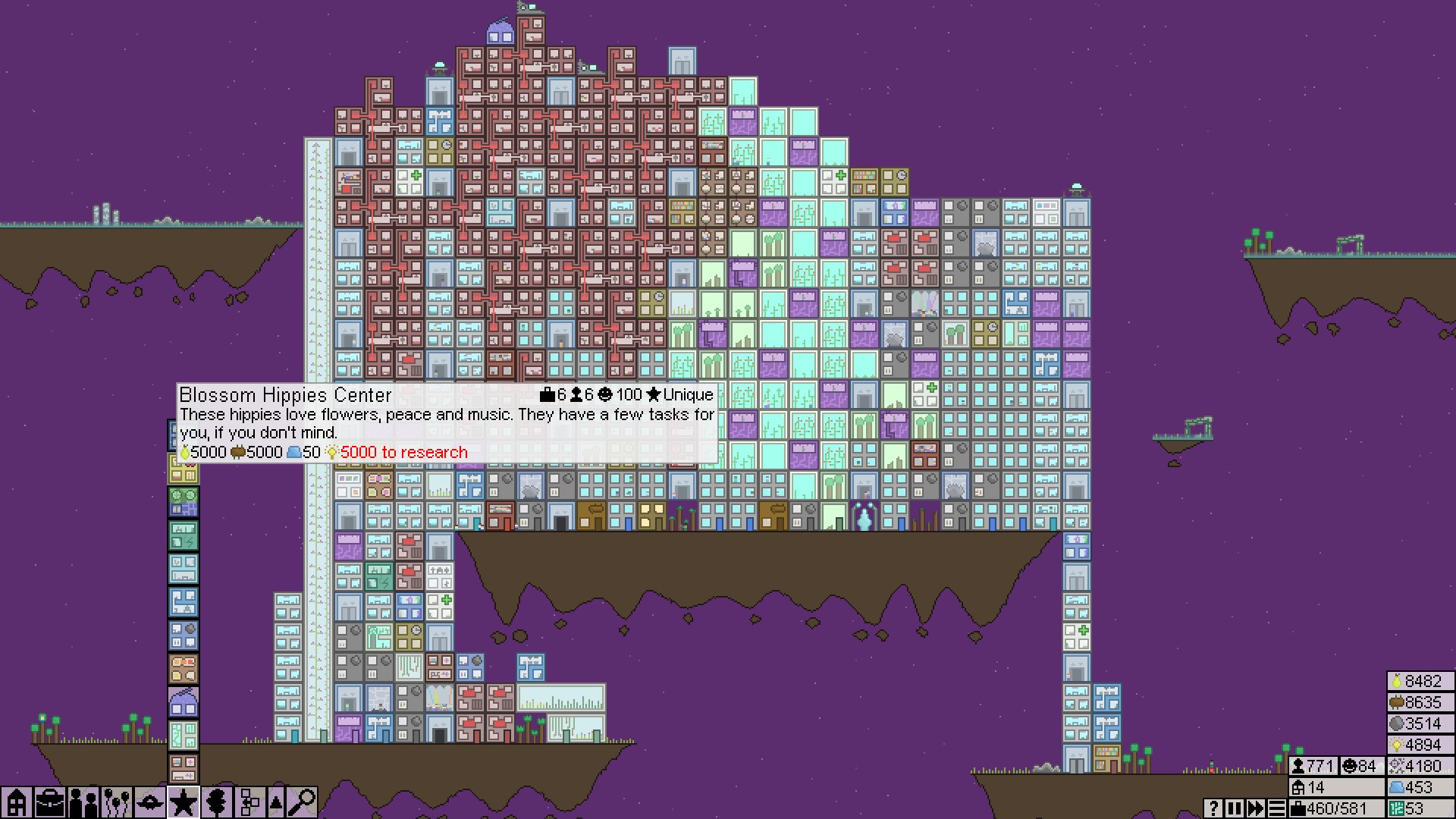
All told, this isn’t a particularly hard game, although you can be surprised by sudden resource shocks where not having enough of a material grinds the whole system to a halt. (If you run out of food, happiness plummets, which makes productivity plummet, which means less food is produced…) It’s still more of a game where you zone out and just watch it run and constantly add more and more onto the tower until holy crap, why is the sun coming up?! How long have I been playing?!
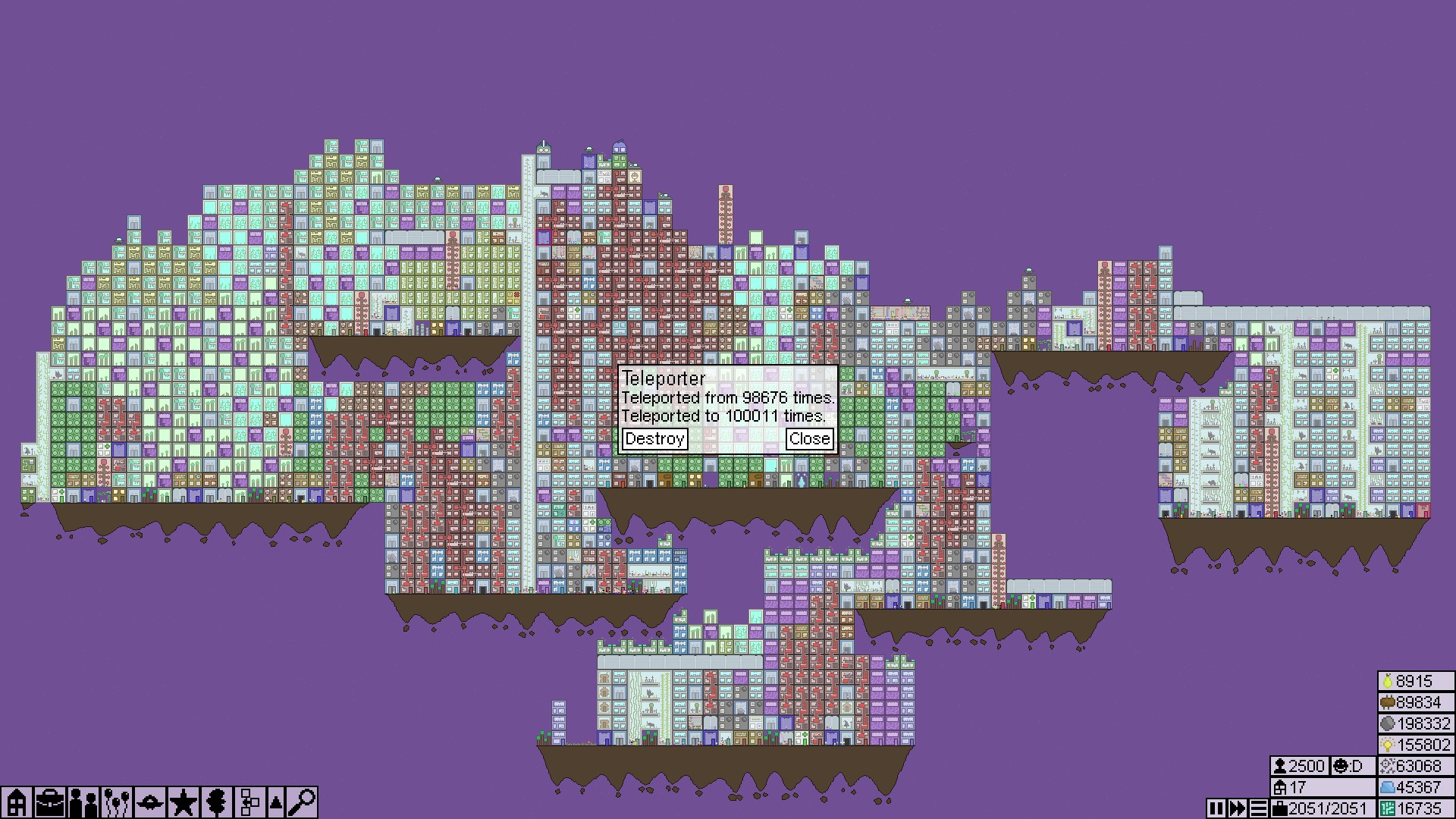
The demo is amusing, but it may lack the ability to keep audiences entertained if there isn’t more complexity added to make successive missions actually different from one another. Different missions in the tutorial may move the rocks around, but the game still stays the same. Provided more content is added to the game as it comes closer to a full release, however, this could be an unassuming gem for relaxing management types.
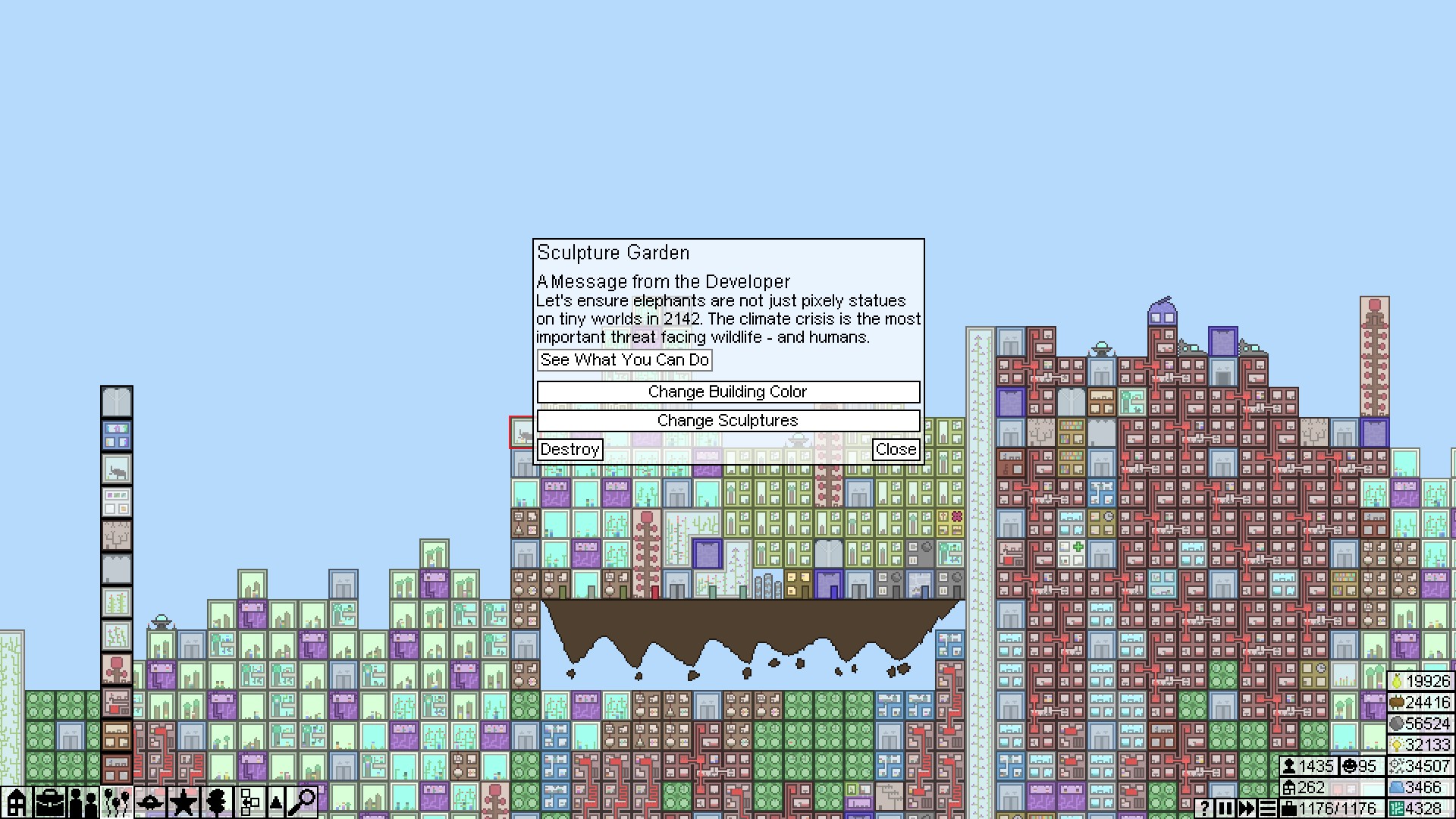
The Hand of Merlin
OK, looking at that trailer, you’d think The Hand of Merlin (which is made by way bigger names than anything else on this list) is going to be another tactical RPG, right? Well, actually, the game Hand of Merlin seems to be most cribbing notes from is the much lower-profile Hand of Fate franchise. The map that you glimpse briefly in that trailer is the main playing ground, and it’s only occasionally punctuated by tactical combat, while most of what you’re doing involves a storybook being brought out and journal entries for you to read and respond to with multiple choice. They even brought out the “pick one of four cards” mechanic of Hand of Fate, although they don’t let you see them before they get shuffled to have some chance of following the card.
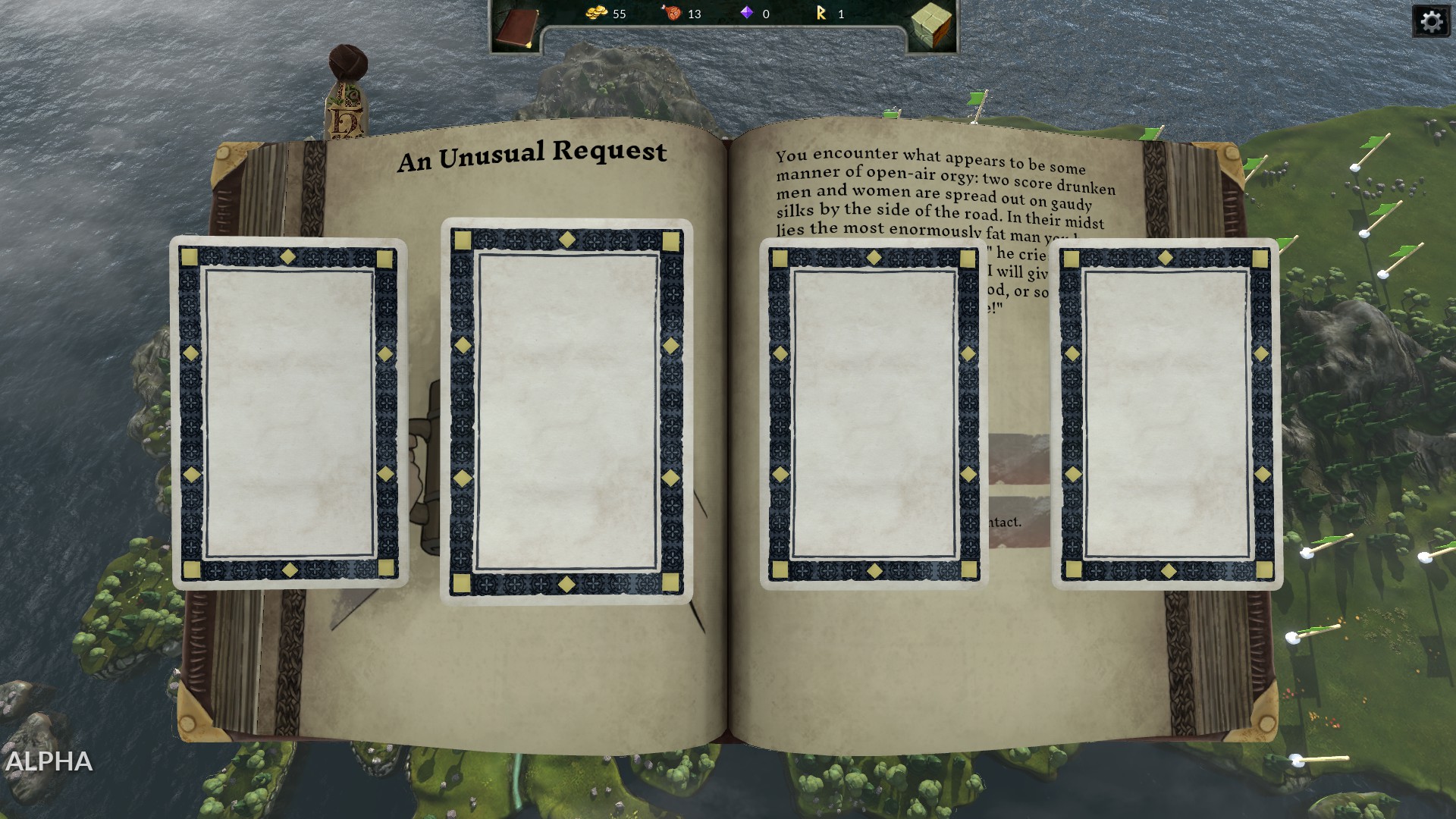
The multiple choice in question generally amounts to either solving riddles or else being given some sort of “honor versus practicality” morality play. Again like Hand of Fate, you have gold and supplies that drain down as you move forward, forcing you to constantly forage for more food in the multiple choice without compromising your knightly honor.
Compared to the other tactical RPGs I’ve covered so far, Hand of Merlin has by far the least depth to it, but it’s also surprisingly little of the game. After a single tutorial combat at the start, I basically never saw combat again, making the trailer almost feel like false advertising. It tries to make up for this with variety in terms of multiple-choice responses to those storybook puzzles and the card games of chance. However, any games that rely upon disparate mini-games can start to suffer from having each component part of the game wind up being shallow and eventually boring on their own, dragging the game down while a game that focuses upon refining a lot of depth into a single core gameplay loop can keep players going longer. The big weakness of Hand of Fate was that it still just went into boring button-mashing combat when it wasn’t doing its more interesting card-based gameplay. The Hand of Merlin, however, lacks the deck-building mechanics of Hand of Fate or the way you can game the system to make even its random elements feel like something you’re participating in, rather than having told to you.
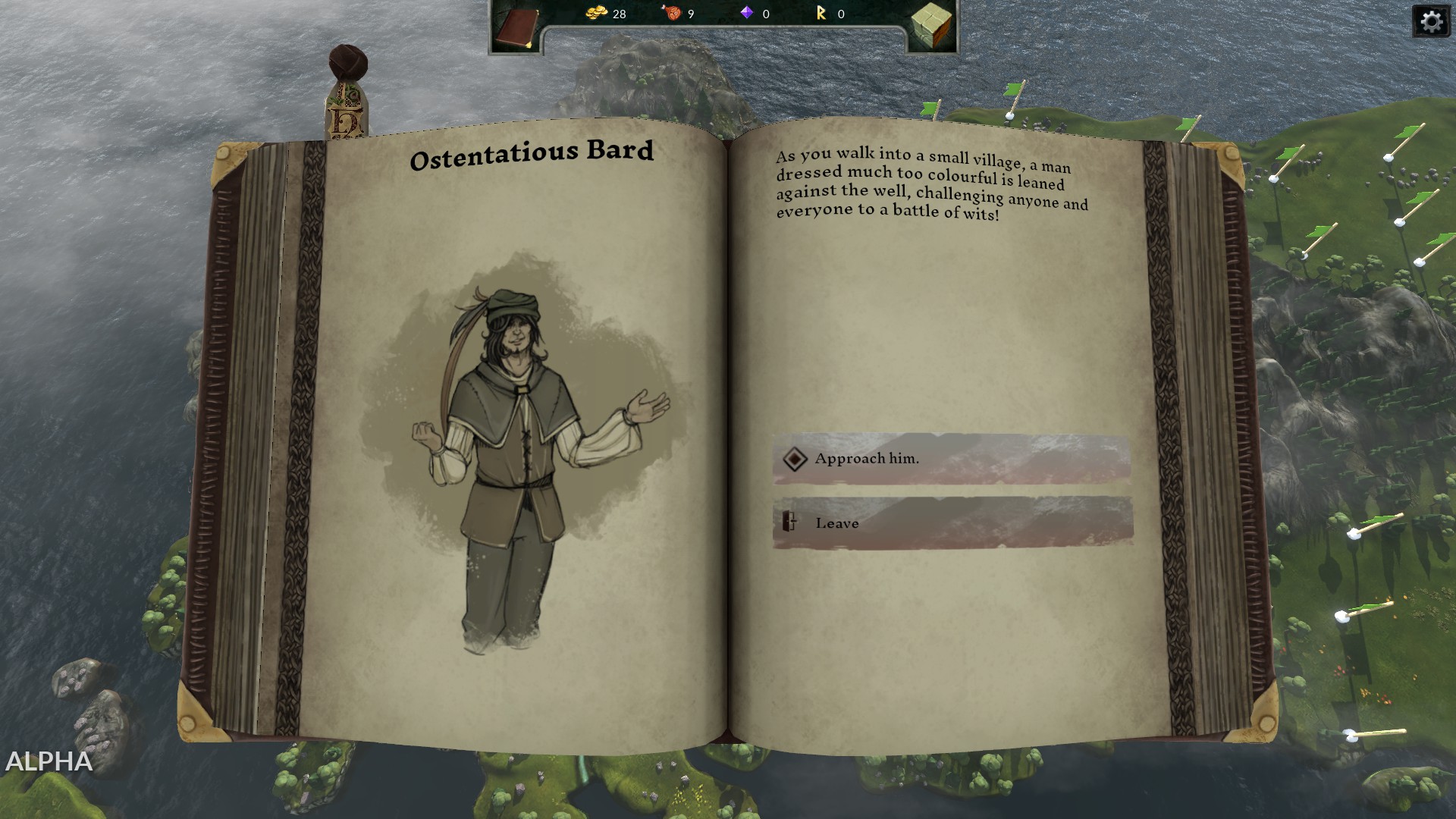
Ultimately, this is the problem with The Hand of Merlin: It’s a drab, somber game all about the self-importance of its own story without giving me any reason to care about any of these characters or what happens to them. It wants to make a bleak Fall of Avalon story bleaker by invoking eldritch horrors for some reason, but without any buy-in from the player, it’s just running straight into what TV Tropes calls “Darkness Induced Audience Apathy”. Everyone’s going to die anyway, so who cares? For added bonus points, it has the “we don’t have enough time or resources to make a deep or long game, so let’s make it permadeath and force the player to restart a bunch through trial-and-error gameplay to pad out its runtime” variety of cheesy roguelike, hiding its lack of ambition behind being a “hard game” (in multiple-choice format).
Haven
OK, so this one isn’t a strategy game at all, and rgk already covered it, but I’m blaming Steam’s bad categorization/tagging system for this one.
This one might as well be called “Daft Punk: The Videogame”, because it feels very much like that Interstella 5555 music video album they did, right down to the music style. (I was not at all surprised to find the developer is French, as well.) You very much can play this game more for the aesthetics than the actual game in this game. It’s filled with synthy music, pastel color schemes, lots of glowy stuff that doesn’t make much sense but is described in obviously metaphoric terminology while everything good glows white-blue and bad stuff is black and red. Our two lovebirds apparently crash-landed on a mysterious planet running away from an organization called The Apiary using their spaceship that’s just called “the Nest”. (Get it? Because they’re lovebirds?! It’s because they can’t be caged, and won’t you flyyyyy hiiiiigh freeeeee biiiiird, yeeeaaah! The allegories in this game seem as subtle as a freight train derailing into your living room.)
Haven focuses upon a couple in that really cuddly-clingy phase that would annoy all their friends and neighbors if there were any on the deserted planet they crash landed on. Similar to Divinity: Original Sin, you have a co-op dialogue system where co-op players take turns making multiple-choice responses to one another. One of the choices I made raise some sort of unlabeled bar I have to assume was something like an experience bar, at that.
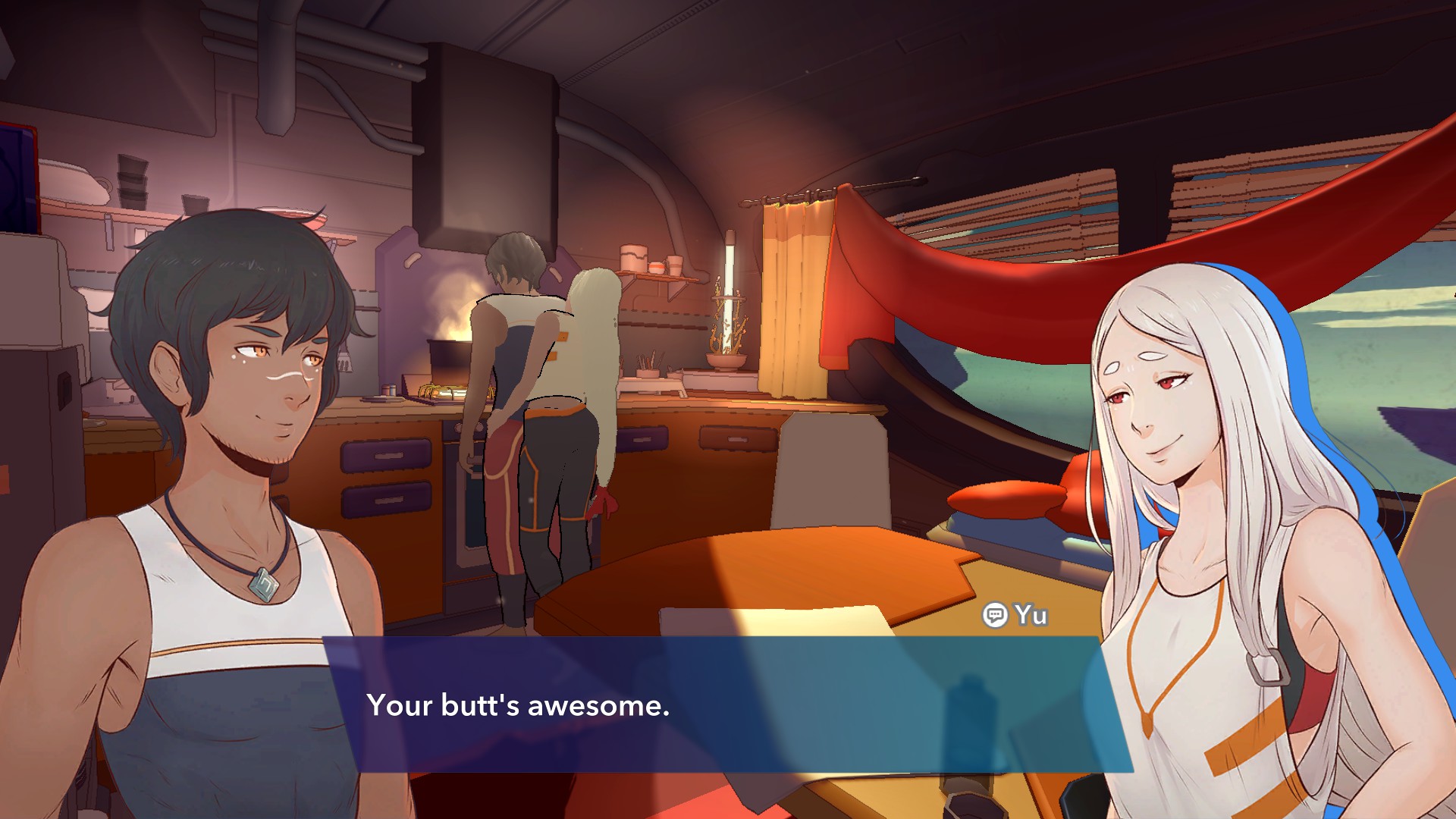
The game’s Steam page suggests you play it either solo or “co-op with a special someone”, and it’s pretty obvious why they aren’t suggesting it for co-op more generally. Most co-op games cast you as something like mismatched robots or criminals forced to work together or else siblings. Even the few games that make you play as husband and wife pairs tend to just do it abstractly by making it so that a tuxedo-clad groom gets matched up to the dress-wearing bride to complete a mission. It’s easy to see your typical co-op player of a couple dudebros that decided to play some couch co-op while drinking beer and eating pizza starting to get really uncomfortable when being told to select dialogue options to get the other partner more in the romantic mood before they start clearly getting ready to screw like rabbits on the kitchen table. (Yet speaking of uncomfortable silences and trying to prove you’re not gay, there’s sadly no hint of inclusion for LGBT audiences, which is pretty sad for something so clearly focused upon the intimate.)
Beyond that, gameplay largely involves using your futuristic hover-boots to glide around at high speed like Sonic but with more glowy bits while picking up food, forage, and “flow” (glowy paths you need to follow in high-speed hover mode) as energy to combat the corrupting “rust”.
Speaking of which, the fact that they had combat at all kind of seemed surprising to me after seeing the rest of the gameplay, but it’s largely a “block the heavily telegraphed attack” system that is made much more difficult through the way that your own actions have about two-to-three seconds of charge up to even enter the command before locking you into an attack animation for another 5-8 seconds. If you do combo moves by both punching in glow beam commands at the same time (either mashing both sticks on the controller inward or outwards if playing solo – the keyboard commands did not appear for me because I had a controller) and then timing the release to the same time – a much more difficult feat when playing co-op.
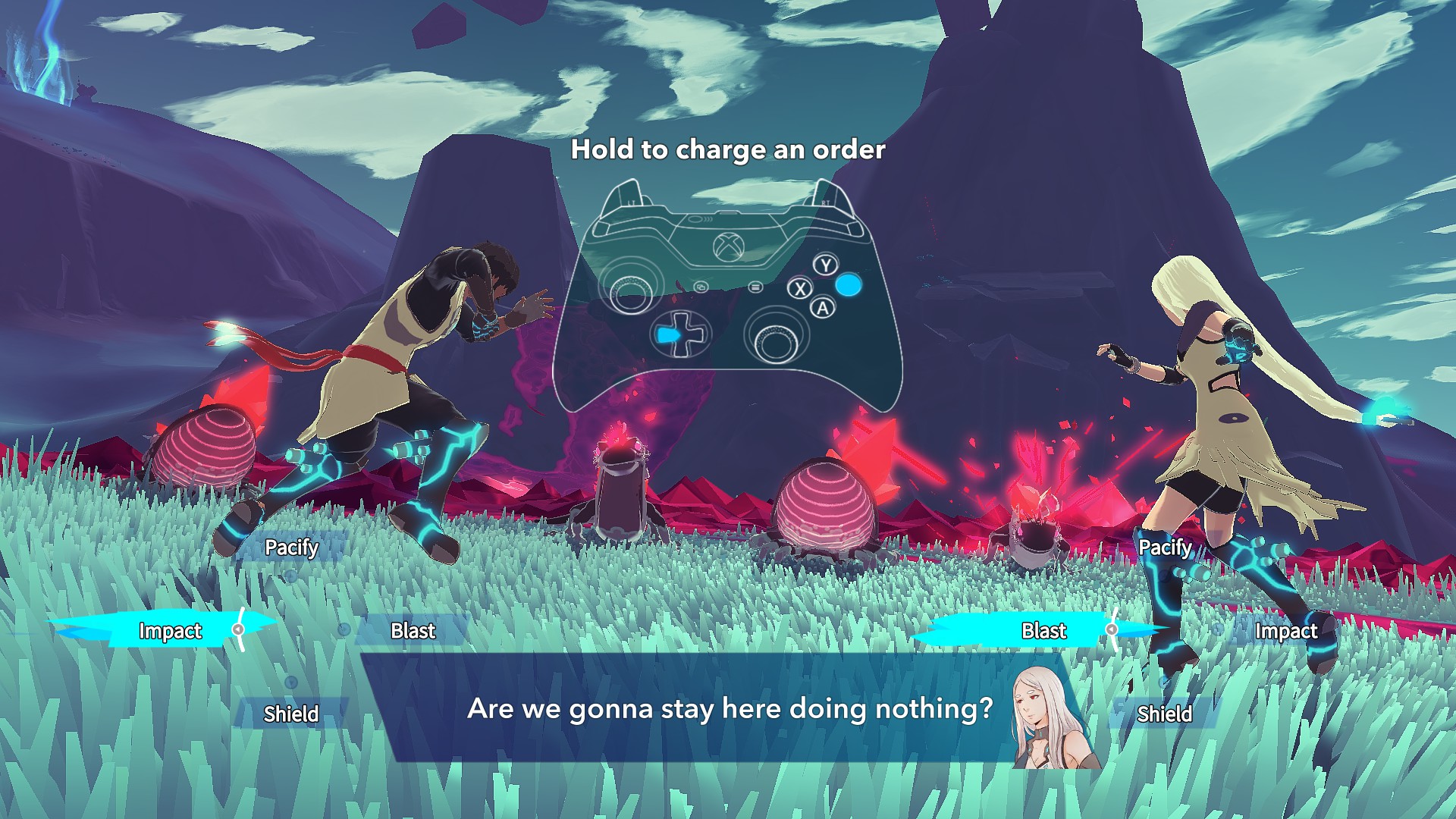
This demo was sadly rather short, but it certainly looks well put-together and interesting from the aesthetic and storytelling standpoint at the very least, so it’s probably one to watch going forward.
Pendragon
And here we have two overly melancholy King Arthur games on the same list! This game tries to be a somber and serious even darker retelling of a story that already bemoans the tragedy of lost honor far too much just like the last one, as well, but doesn’t bring Lovecraft into it, at least.
Pendragon wants to be a chess-like strategy game and yet another “short so we’re going to make it unfair and trial-and-error permadeath” style of “roguelike” that fails to understand what made the classics of the genre like NetHack good were their high degree of options that could drown the player in choice. Those proper Roguelikes are notorious for their YASD or “Yet Another Stupid Death” because when you fail in those games, you instantly realize what mistake you made, and have a burning drive to hop back in and try again armed with your knowledge of what went wrong.
Pendragon is a game that tries to feel like chess, but where it keeps breaking its own rules to make the player fail for no apparent reason. You have a “move orthogonal” mode and a “more diagonal” mode that takes a turn to switch between the two. The diagonal movement mode says that you cannot attack in that mode, so that implies that you can attack in orthogonal mode, right? Well, not if you’re playing Guinevere, apparently. Or maybe it’s when you’re fighting bears? Who knows, the game won’t tell me, and I lose when I try to attack those kinds of beasts, forcing me back to the start.
Because of the I-go-you-go turn order (even when you have multiple characters, one unit per side moves one character per turn) and need to move orthogonally to attack, the game basically amounts to waiting for the enemy to step into your killzone without moving into any killzones yourself. This means that in the really cramped maps, you’re basically constantly forced to retreat or wait until the enemy makes stupid moves, and the enemy just sits there waiting you out.
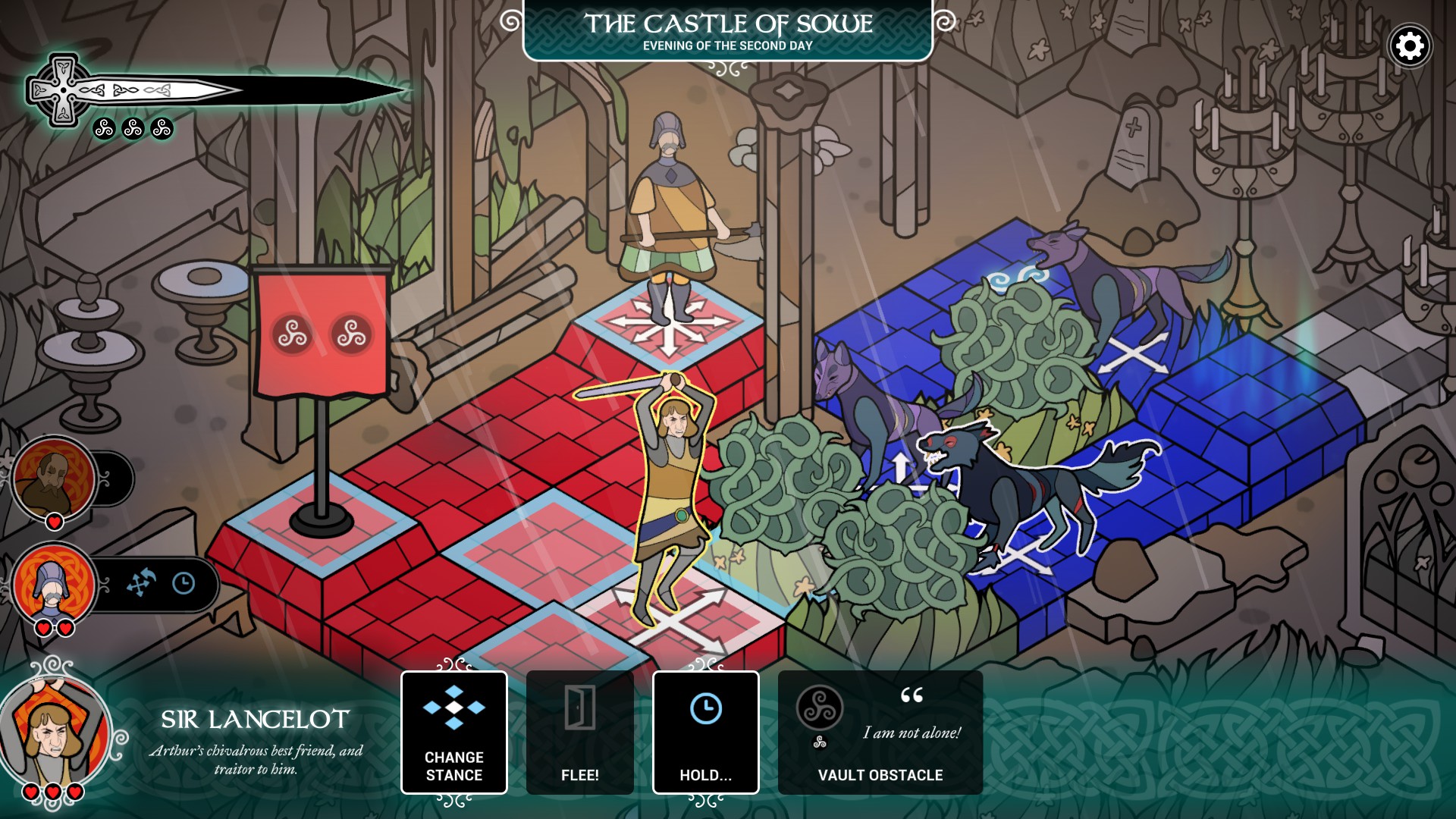
Now let me describe how this game actually plays for second. You have to click on a space to move to. Then, it asks if you’re sure you want to move there. Then it has the same dialogue you already read every time you started a new playthrough that’s totally unskippable. Then you have to switch stance because you need to move diagonally next. Then you have to confirm you are switching stance. Then there’s more unskippable dialogue. Then you have to click to move. Then confirm you’re clicking to move. Then more unskippable dialogue. That’s how you move two spaces in this game.
I suffered this game for about 45 minutes before deciding I didn’t want to learn how to play it. I’m sure if I’d stuck with it, I likely would have realized whatever the trick was to overcome misunderstanding that got Lancelot killed last time, but I also realized that there was absolutely nothing appealing in this game to make me want to try. It is slow, tedious, boring, frustrating, and it straight-up lies about its rules to the player to force them back to start so they can suffer through it again.
Skip this one and never look back.
Starmancer
On the one hand, this is a game that has all that city-management stuff I like with a dash of that Dwarf Fortress procedural flavor to it and it has an art style reminiscent of PS1-era games like Xenogears with the highly pixelated textures on low-poly 3d objects. On the other hand, this also feels an awful lot like Spacebase DF-9, the notoriously abandoned Double Fine game.
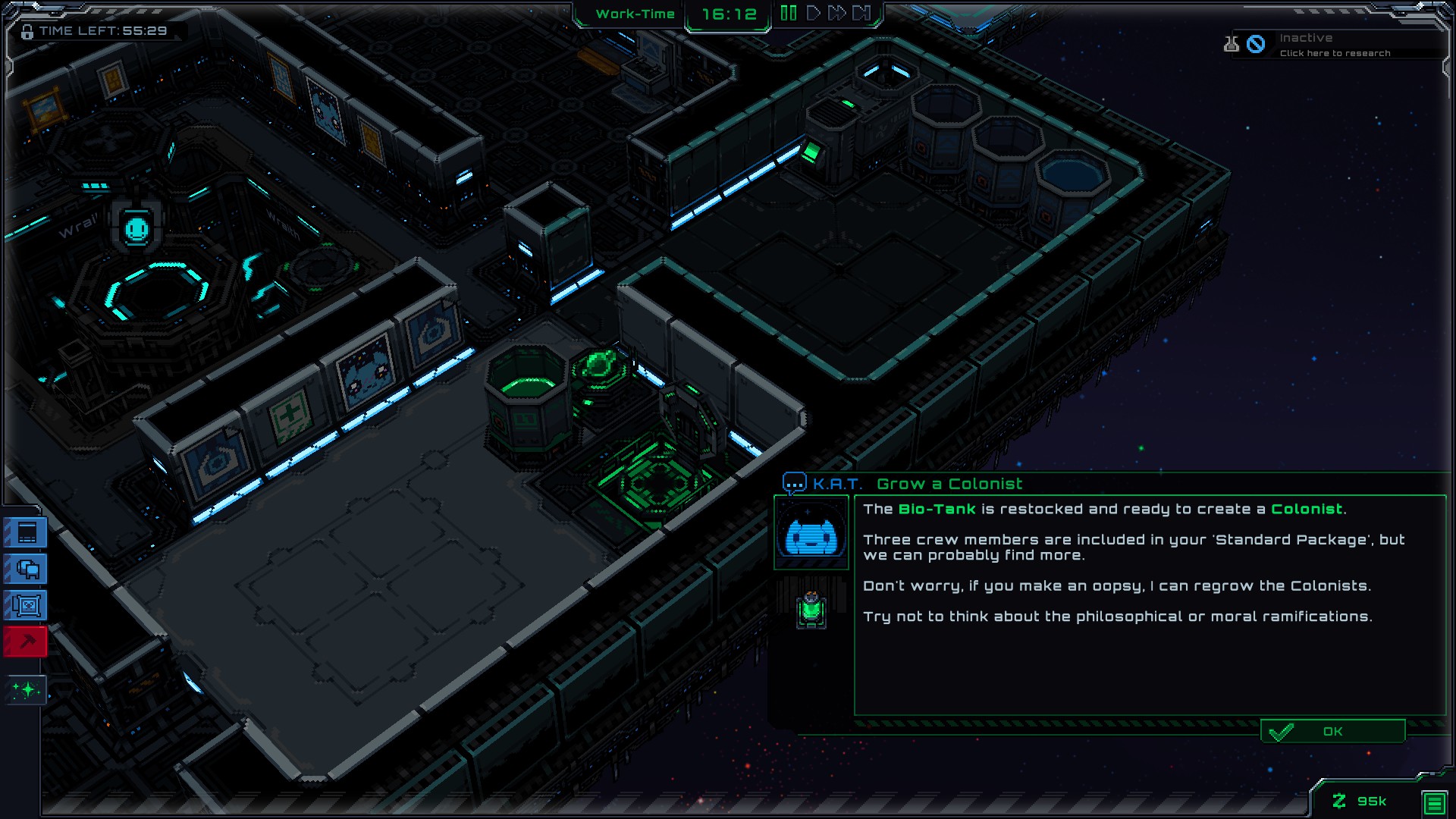
Starmancer is a base-building game in the “like Dwarf Fortress but with graphics and in spaaaaace” subgenre with a distinctly cyberpunk dystopian capitalist nihilism bent to it. You’re an AI charged with working your human drones to the bone to make you money because… well, because that’s what you’re programmed to do by your corporate overlords… I think. Actually, I’m not sure they exist? The trailer even kind of implies you’ve been abandoned in space for an indefinite amount of time. Well, it’s your programming to make a buck selling the random junk (including the poop) on your space station to… some unnamed entity that can buy anything from you from anywhere in the universe.
Look, stop thinking rationally about the situation, and just start plunking down space station parts so you can start running a mostly self-sufficient base that wont’ go bankrupt.
After getting the basics up and running (by which we mean power is on and you have an atmosphere contained), you can start growing your colonists in a vat. Unlike what the trailer implies, however, you only get three colonists at the start. You can regrow them if they die, but you can’t clone another one of the same person until the last one is dead, so you’re stuck with a limited number of colonists/capitalist slaves until you can “rescue” some corpses off of escape pods to add to your DNA collection. To make these characters be at least a little more than just a stat block, these colonists also have exactly three randomly-determined traits that add some positive or negative aspect to the character.
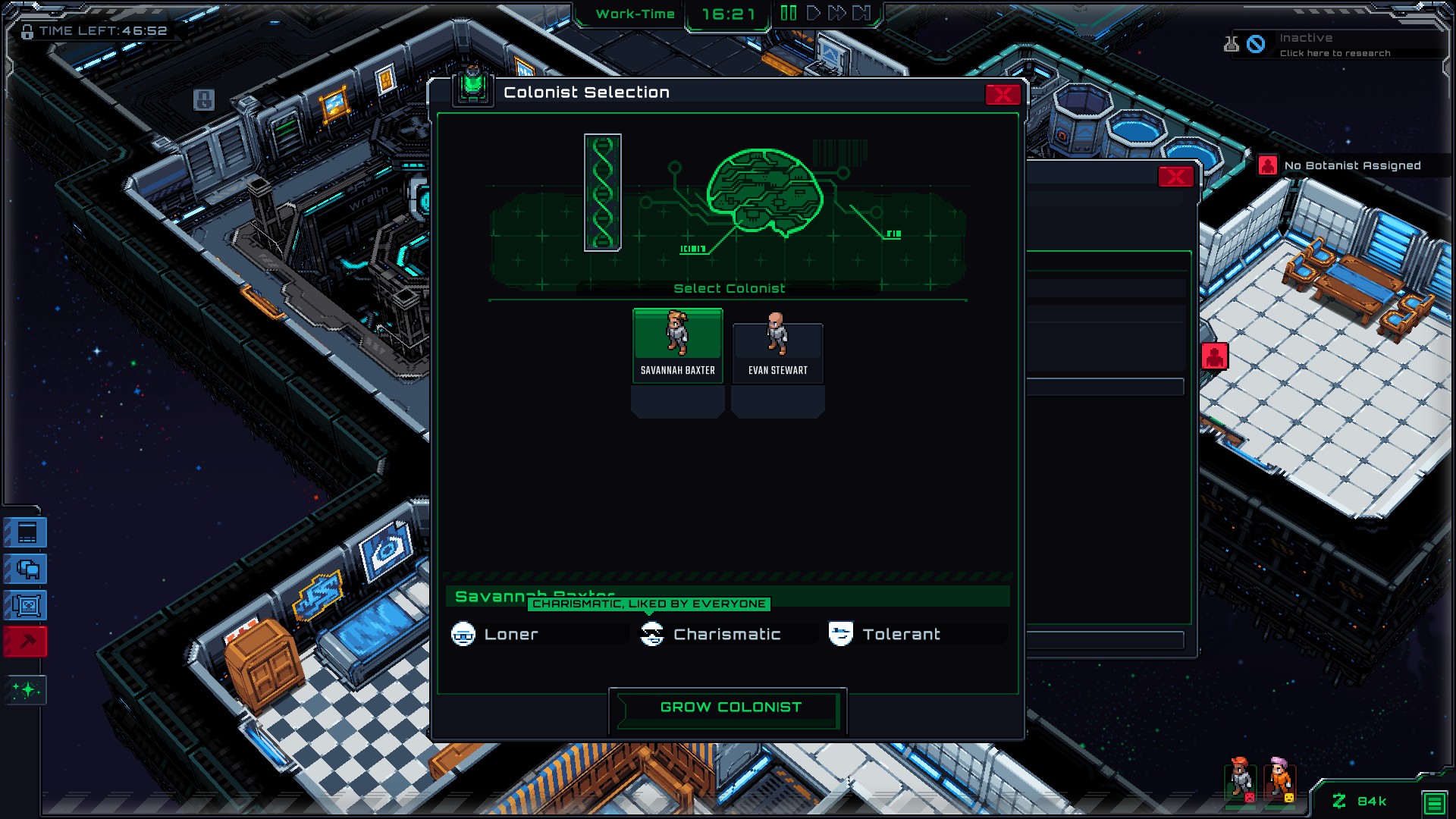
Colonists have a Sims-style set of gauges demanding constant filling while they also behave according to a universal day-night cycle (informed by the brightening/dimming of the lights) so that they all sleep at the same time, rather than whenever they’re tired, Dwarf Fortress style. There are the “morale” needs of things like fun (which goes down when working on a job they aren’t experienced in), safety, and socialization, as well as immediate needs like oxygen, temperature, food, and toilet. (Note: You have to research and unlock the toilet after ranking up skills – before then, they just go on the floor. The same with beds, but that’s not as disturbing. Also, because poop is a resource used in the chemistry chain, characters will run over to collect each other’s poop and store it on the shelves I put into their room for decorative purposes.)
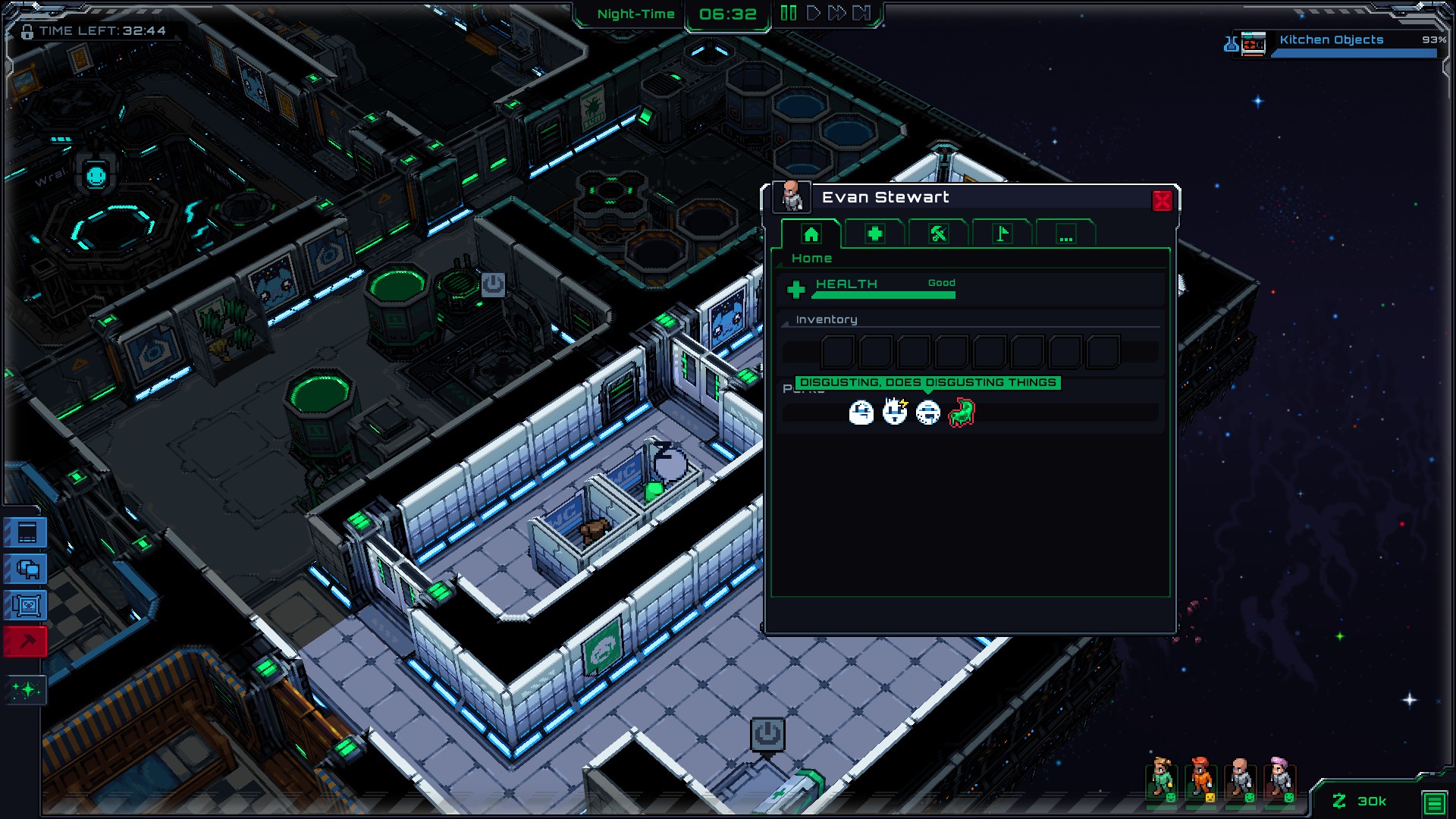
The demo features a relatively modest suite of customization features, but that’s really the sort of thing one expects to see fleshed out as it heads out of beta, and it’s already not particularly bad so far as being able to make different rooms have different aesthetic qualities. Putting down sheet metal in the industrial rooms, sleek white tiles in the doctor’s office, friendly checker tiles for the kitchen/dining room, and carpets in the bunks can make things feel homey or even more dystopian depending on your tastes. (Although it’s hard to square the flippantly psychopathic tone of K.A.T. and the item descriptions with actually trying to make the lives of your colonists not suck.)
But then I have to come back to that Spacebase DF-9 comparison. The genre of “like Dwarf Fortress but with graphics and…” games is littered with broken promises and abandoned games as either the developers lose interest in the truly Herculean task of creating such a complex simulation or the publishers realize that the market for this genre isn’t as large as the list of features such a game needs to pull off. Towns, Gnomoria, The Kindred, and the aforementioned Spacebase DF-9 just to name a few are the corpses of failed Dwarf Fortress contenders on Steam alone. The trailer above is from 2018, and it doesn’t look too different from today. Ominux Games is apparently a two-person dev team, and Chucklefish as a publisher doesn’t inspire confidence in maintaining long-term relationships with its developers. Against this, Rimworld stands out as the only still-standing contender against Dwarf Fortress, which is coming to Steam itself, soon. That’s not to say I’m predicting its failure, just that I’ve learned to have an abundance of caution before getting into this genre with both feet.
So I’ll be following this game… but probably not with bated breath. This genre has burned its niche of adherents a few too many times to go all-in on the hype train.
Stronghold: Warlords
This may be giving the review away in the first sentence a bit, but you’ll probably learn more about how this game plays watching that trailer than playing the demo for the game. I’m not saying that Stronghold: Warlords looks like it will be a bad game, but it certainly has the worst demo out of all the games here, even compared to the games whose demos I hated playing.
There is no main menu for the demo. You launch it, and it gives you a message that largely amounts to “kill the bad guy to win” with “optional objectives” of “use the diplomacy menu to get the neutral guy to give you weapons you need to win”. There is essentially no tutorial at all. None of the interface or how to use it is explained except pressing space to open the diplomacy menu. (And they make “P” be pause like this is still the 90s!) You’re just dumped into a ridiculously tiny map next to a creek where either side attempting to cross will immediately be within bowshot range of the other side. You can’t even save or load, but since it’s one tiny map that takes 30 minutes if you’re cautious or screw up a few times (almost all of which is spent waiting for resource numbers to go up so you can spawn more guys), that’s not of terribly much consequence.
There’s an already-built village for you, although there are no walls, and I seemed to need to build at least four more rice paddies and one more house before the game would shut up about being out of rice. Other than that, management is left completely
The enemy just stands there behind its walls, sending out four horse archers every two minutes but otherwise just sitting around waiting for you to show up and kill them all. If you kill an archer on a tower, they won’t bother to send anyone else up to replace them. The AI seems almost nonexistent. If you fail in an assault, just wait for money and influence to accrue and order more sieges from your allies while sending in your own units to swarm.
For a game explicitly about castles and castle defenses, the walls seem to do nothing. As in, there seems to be no difference between archers fighting on the ground shooting up at archers on top of the towers, except that the tower archers have slightly better range.
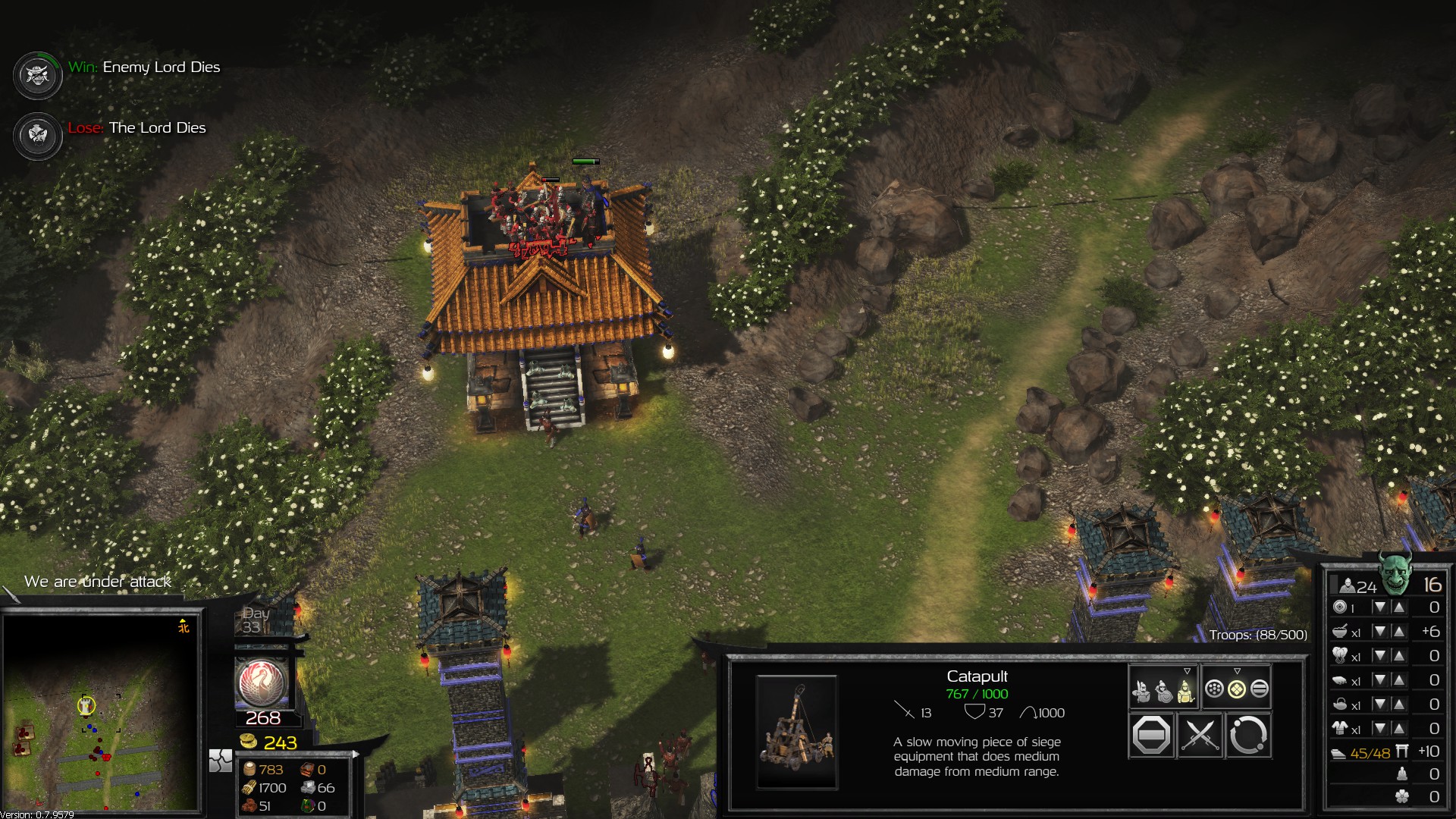
Again, I don’t think Stronghold: Warlords will be a bad game, but it feels heavily like this demo was just some pre-alpha proof of concept that was kicked out the door to say they had something and that they could therefore get the advertising from Steam’s spotlight on them and their live developer stream.
The game as it stands almost feels more like it is trying to be Age of Empires more than Stronghold, however. The first Stronghold was a classic, while 2 was a letdown, so FireFly has something to prove about how they’re correcting the course and coming back to the gameplay that fans loved about the first one, and this “demo” isn’t proving much.
Ten Thousand Coins
Rounding out this list (alphabetically), we have Ten Thousand Coins by TL-Tonic. With a fox-girl heroine trying to hide her non-human identity while engaging in medieval economics via wagon, there’s more than a faint whiff of Spice and Wolf as an inspiration. The fact that the second trader is straight-up Brock from Pokemon says this probably isn’t an accident. As with a lot of stories where the main character needs to obtain an obscene amount of money while still seeming relatable, the main character is saddled with a debt, and you’ll never guess the exact amount of coins she’s going to have to repay. Standing in the way of this is that not only do people pay less for what you sell unless it’s one of the two things they specifically are requesting, but selling goods for coins also has a crippling 30% tax. You thus have to rely upon bartering, which requires constantly having a stock (in a very limited inventory space) that you can actually barter for things roughly on par with what you’re trying to barter for.
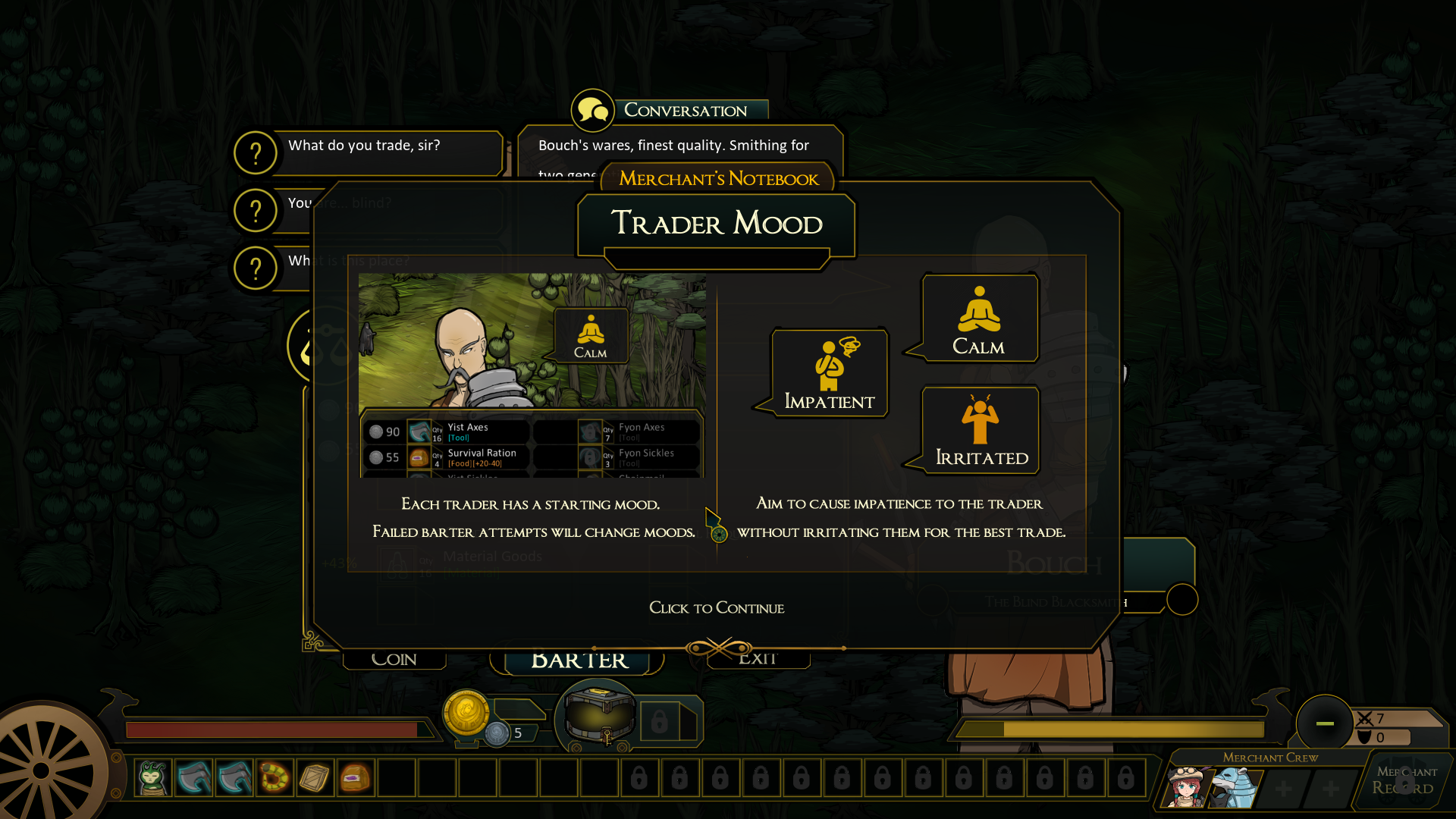
Trading is not all you do, however, as the roads are filled with hazards, and not just multiple-choice vignettes, but combat mini-games, cart repair bars, hunger meters, and more!
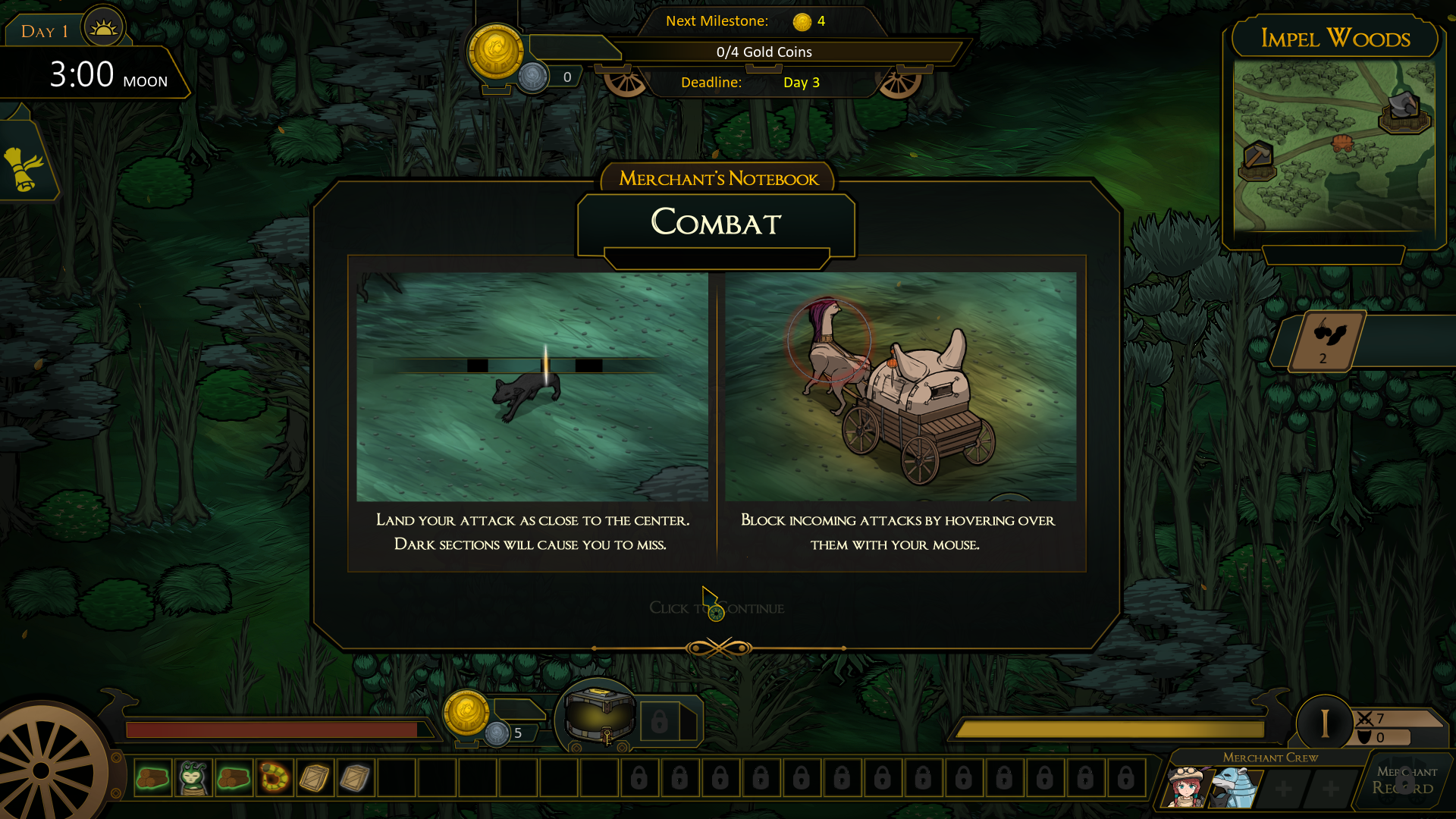
Although at first it seems to be just trading, the game also features a form of combat where attacks are based upon clicking to stop a slider near the middle (which always seemed to lag quite a bit past when I clicked…) and then reducing damage by moving the cursor to where the attack ring is lighting up. Combat is more dangerous than in most games thanks to the fact that it’s your wagon taking damage, and there’s no way to repair outside of towns that have an artisan’s guild (and even then, only when the game lets you), so bribing enemies you could defeat off just to avoid the damage may wind up being the less costly choice.
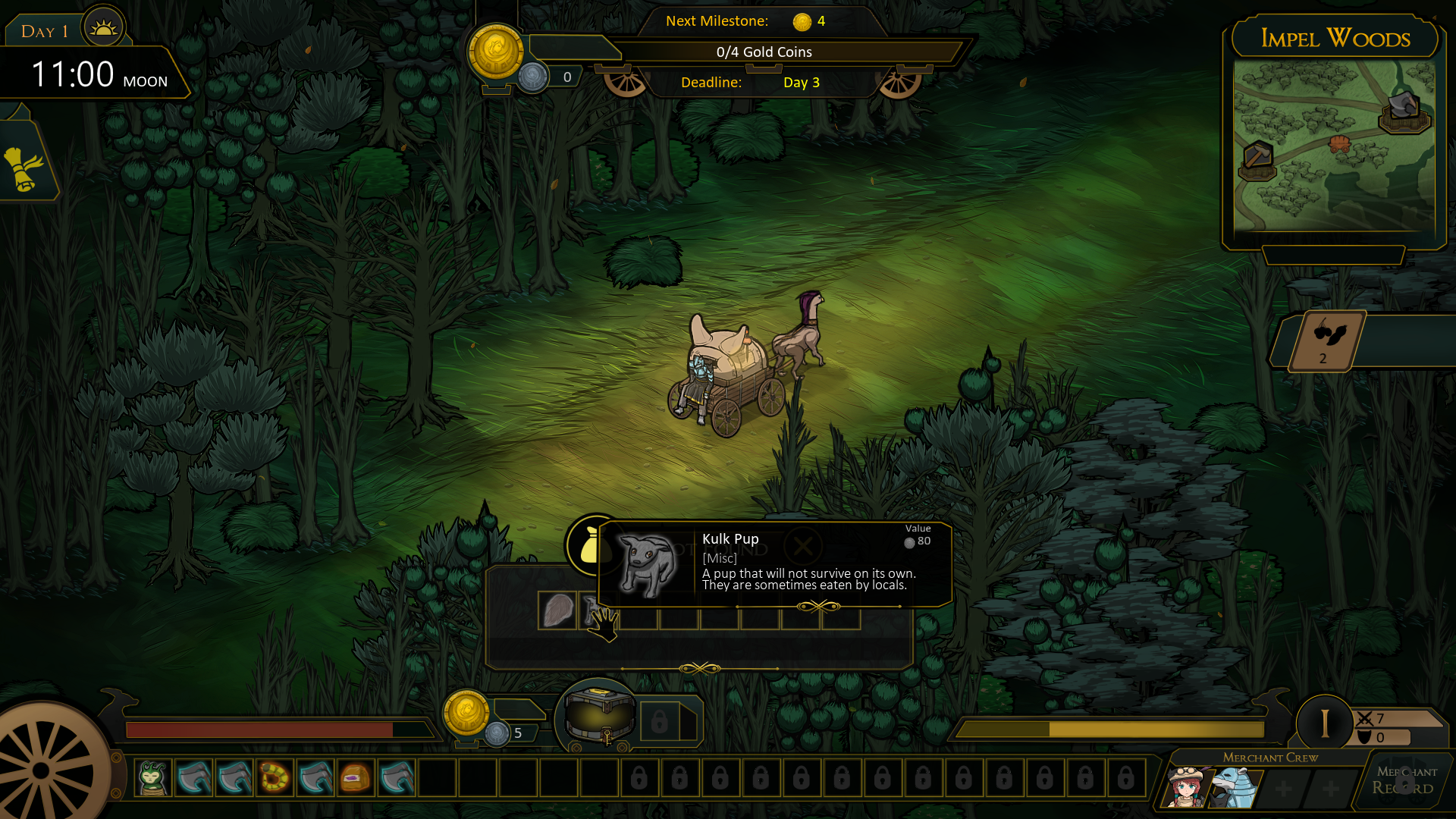
Sadly, I was also playing these games alphabetically, and the demo time expired on this one before I could give it a full review. For a game with a very small team, this seems to be an ambitious game that tries to keep many balls in the air at once, so it’s a pity I couldn’t get more in-depth on it. As I said before, many games that try to juggle many different mini-games rather than a single core gameplay loop tend to leave everything feeling shallow or making one bad minigame drag the rest of the game down. Ten Thousand Coins has to flesh out mercantile trade routes, visual novel choice and consequence systems, and a combat system. That said, if it manages to pull off its ambitious spread of gameplay types in a way that prevents them from becoming repetitive over time, this is definitely one to watch.

